ISPP REMINDER
January,
2008
HAPPY NEW YEAR ! !
OUR NEXT MEETING. . .the Annual Tri Physics Meeting: ISPP, Physics West and Physics Northwest
. . . is at Elmhurst CollegeWednesday
January 9
NOTE TIME -------- 5:30 - 9:00 p.m.
5:30 for Pizza before the regular meeting at 6:30.
THE FREE GIVEAWAY . . .
. . . is always a neat thing at Elmhurst, thanks to the ingenuity of Earl Swallow our host there! Can you guess what it will be?
Future Meetings
February 7th (Thursday) Northeastern Illinois University – Paul Dolan
March ??? CSAAPT Spring Meeting
Click here
for directions and a map.
…John Milton welcomed us to DePaul University with a wonderful demonstration about how temperature changes in a boiling beaker of water. He used an immersion heater placed in a beaker of water. Three temperature probes were connected to a Vernier LabPro and recorded the temperature at three locations in the water. One probe was near the bottom of the beaker of water, one probe was near the heater and the other probe was near the surface of the water. It was neat to see how the temperature of the water, which started at room temperature, does not increase uniformly throughout the beaker, nor uniformly with time. First the surface water heated and the water near the heater heated. It seems the warm water rose quickly. Then those two probes rose simultaneously in temperature for a while until they reached near the boiling point. They then stabilized, and the temperature in the water at the bottom of the beaker started to rise. When that reached the same temperature as the top and middle probes, they all rose the last few degrees together. There was some interesting debate as to how the results would differ if the beaker were placed on a hot plate, or over a Bunsen burner.
Annoucements…
Scott Beutlich sent an e-mail about an opening second semester in physics at Warren Township High School in Gurnee, IL. You can contact Contact Doug Domeracki via email or phone ASAP. 847.347.1158 ddomeracki@wths.net.
| A new teacher bag was given to Anthony Escuadro of Harold
Washington College. Welcome to ISPP and have phun teaching!
Art Schmidt told us about summer research positions at Northwestern University for undergraduates and high school teachers. The information can be found at www.mrsec.northwestern.edu and the application deadline for teachers is March 15. The application deadline for undergraduates is February 15. It is an 8-9 week program and there is a stipend associated with it. The CSAAPT is still looking for the ideal date for its spring meeting. Textbook author Randy Knight is scheduled to speak for us when we meet at Harper College in March, but the date is yet to be determined. Bill Blunk announced that the (green) Jasper laser pointers in the "Basement" sale section are now just $29.99 (plus shipping). The URL is http://www.jasperlaser.com/index.php?/forms/basement. |
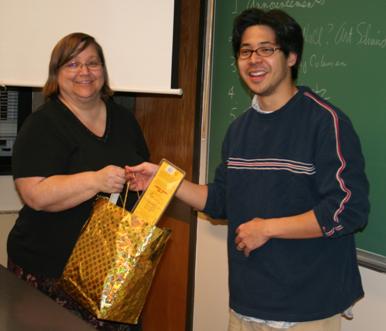 |
The Harald Jensen award will be announced at the Elmhurst meeting in January and presented at the Lake Forest meeting in April. Come hear whom we will be honoring this year for his or her outstanding phenomenological teaching. This award is given to a relatively new teacher (less than 10 years experience) and is rotated between the three physics alliances, ISPP, Physics Northwest and Physics West.
Pete Insley informed us that Columbia College is looking for a chair for the science and math department, and also has a tenure track physics position open there.
Art Schmidt (Northwestern University) showed us a video clip from YouTube about burning H20 over saltwater. The students take regular CokeTM and put it in a glass and use a TV signal transmitter to ignite the Coke (“How to Ignite Coke” http://www.youtube.com/watch?v=lWukQIOL-F0). What is happening here? One person speculated that the Coke was spiked with alcohol. He also pointed out a news clip about John Kanzius who set a test tube full of saltwater on fire using radio frequency waves. (“Saltwater Burns- John Kanzius” http://www.youtube.com/watch?v=h6vSxR6UKFM) There was an interesting discussion regarding how people could be fooled into thinking this is a remarkable new energy source, neglecting the power that must go into producing the radio waves that ignite the saltwater or CokeTM. There was also much discussion about which fluids would work.
Art also had a question about a cheap and easy way to calibrate a Hall Probe. He found a Swiss source for a calibration device, but the cost was 3800 SF. He is using a probe that measures in the range of 600 mT. Gerry Lietz offered to let Art bring the probe to DePaul to calibrate it since he would only need it to be calibrated every couple of years or so.
Roy Coleman (Morgan Park High School, retired) told us that the Air and Space Magazine from Smithsonian has a centerfold on how the CHANDRA x-ray telescope works. To quote Roy, “Very interesting, not much physics.” Roy also related a question about a football pass (such as a Hail Mary pass): what is the torque that makes the ball arc? The front end of the football starts out pointing upwards and ends up pointing downwards. So the torque has to be pointing downwards (in the direction of L). One speculation was that the air drag or air pressure was causing it to the necessary torque to arc the ball. A comparison was made to a rifled projectile which spins on its long axis as it travels through the air. Anyone have any thoughts on what creates this downward torque?
Martha Lietz (Niles West High School) then showed some neat applets from the PhET website (www.phet.colorado.edu). The website has some interesting applets which can be used to have students perform on-line laboratories. The specific applets that she demonstrated included “My Solar System” which allows a student to create their own solar system with a central sun, an orbiting planet and a moon orbiting the planet. Quantitative changes to the distances between the objects and the orbital speeds could be made to show elliptical or circular orbits. Martha also demonstrated the “Masses and Springs” applet, the “John Travoltage” applet (fun!) and the “Circuit Construction Kit (DC Only)”. In addition to the applets themselves, the site contains activities that teachers have created for their students to use these applets. Teachers can also upload their own activities to the site to share with others.
| Tom
Senior (New trier High School) brought some large electrolytic
capacitors from Jordan Supply (345 N. Wolf Road, Wheeling): 1000
µF at
450 V, 2200 µF at 100 V, and 2500 µF at 200 V. They
were on the
half price table and thus cost him only about 50 cents. He
charged them using partially used 9-V batteries he gets from the
theatre department (after they are used in school
performances). If the positive terminal of one 9V battery
is connected to the negative terminal of the next, and so on, a large
DC voltage can be achieved by putting the 9V batteries in series.
Tom hooked up 25-30 batteries and charged the capacitors (being VERY
careful to charge the electrolytic capacitors in the proper
orientation). He was able to draw very nice sparks by
shorting the capacitor with a screwdriver, showing the amount of charge
it can store. For comparison, he shorts the batteries themselves
and gets a very minimal spark. Tom recommends that you do not let
the students play with these because they could accidentally get hooked
up in reverse, and potentially could explode. Or the students
could get a significant shock from discharging them. Jordan
Industrial Supply can be found on the web at
http://jordanindustrial.zoovy.com/about_zoovy.cgis. |
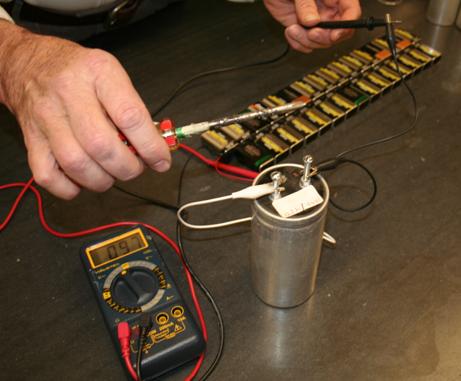 |
| Nick
Drozdoff (New tier High School) showed us the website he is
developing for the Sounds of Music event in Science Olympiad
(http://www.nickdrozdoff.com/scienceolympiad.php). He has some
neat video clips (hosted by YouTube but accessible from his web site)
that demonstrate various and sundry topics related to the science of
sound. Nick has put this together in his spare time to help the
Science Olympiad kids and coaches learn about sound. He has a lot
of information on this site from how trumpets work, to metal chimes, to
multiphonics and Tartini tones. He used some penny whistles
he got at Village Music in Deerfield (an F and a G, a whole step
apart). When he played the two whistles, some of us could hear
the third note much lower: this was the beat frequency of the two notes
and these are called Tartini tones. Nick also showed us a video
where he hummed one note into his trumpet and played another: a
third, higher tone was produced. This couldn’t be a beat
frequency because it is a higher frequency. This reminded Nick of
heterodyning, or might be an upper side band. |
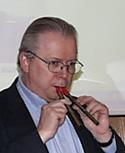 |
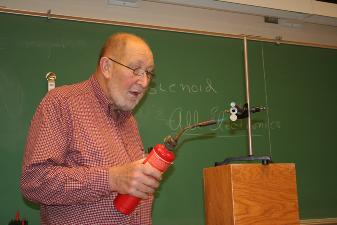 |
Gerry
Lietz showed us two demonstrations related to magnetism.
First he wrapped about 100 turns of bell wire (from the hardware store)
into a coil (solenoid). He then put the coil so it surrounded an
iron nail which was suspended from a 5-N spring scale. When the
coil was connected to a power source, the current pulled the nail into
the coil with a force that was about 1 N. He talked about how
this principle is used in things like starter motors, doorbells, toy
train switches, etc. (doorbells can be obtained commercially from
allelectronics.com very cheaply). |
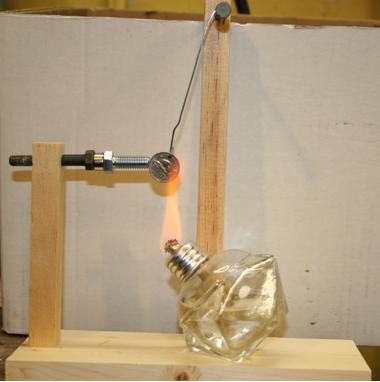 |
with a propane torch. The nickel fell when the Curie temperature was reached, but the iron washer remained attached to the magnet. The Curie temperature for nickel is about 300 °C. The Curie temperature for iron is closer to 700 °C so it would have to get red hot to lose its magnetism. Gerry made a stand for a neodymium magnet and a nickel pendulum. There are two bolts to isolate the magnet from the heat since its Curie temperature is lower than that of the nickel. The stand is designed to hold an alcohol lamp which (if it is not drafty) will heat the nickel, cause it to fall away from the magnetized bolt. Then when the nickel is out of the flame it cools, is attracted back to the magnetic bolt, re-enters the flame, de-magnetizes, etc. If it is set up properly, the nickel will oscillate back and forth as it loses and regains its magnetism. [The magnets are from www.amazingmagnets.com at about $11 for 10, and the nickels are from Colonial Acres in Ontario (www.colonialacres.com) : ask for nickel bullion because you don’t need collector quality coins.]
The meeting ended with Gerry handing out the pieces to make his Curie temperature oscillator (the wooden stands, the bolts, the magnets, some washers, and a nickel with a pre-drilled hole). This was a nice meeting with a decent turnout, despite the snowstorm bearing down on Chicago (usually reserved for the Elmhurst meeting).
See you in Elmhurst.
Submitted by Martha Lietz
Campus
Map

